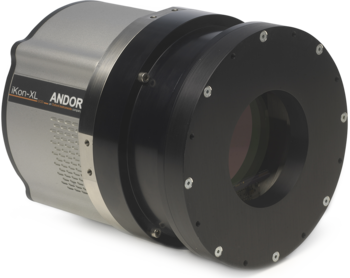Resources
 Part of the Oxford Instruments Group
Part of the Oxford Instruments Group
Expand
Collapse
 Part of the Oxford Instruments Group
Part of the Oxford Instruments Group
Challenge Background
Spectroscopic characterisation is a common methodology in astronomical observations, permitting study of the physical properties of various types of celestial objects such as stars, galaxies, planets, nebulae and planets. Spectroscopic detail can yield an abundance of useful information, including chemical composition, temperature, density, mass, distance and relative speed. Such detail even be used to infer some understanding about that which cannot be directly detected – dark energy!
Wide field spectroscopic surveys often involve hundreds of fibre optics at the telescope focal plane, feeding signal into an advanced high resolution spectrograph, which in turn is coupled to a large area, high resolution CCD detector. In some advanced systems, each of the fibre optics at the instrument focal plane are mounted on precision robots, which can be accurately repositioned and choreographed to exact locations that correspond to where the signals from distinct distant galaxies are focused.
Technology Solution
In terms of detector needs, deep cooled CCD detectors are often utilized, providing superb sensitivity, dynamic range, spectral range, response uniformity and temperature stability. Acquisition times for astro-spectroscopy tend to range from tens of seconds to tens of minutes, even hours, thus satisfying the optimal readout times of CCD technology. It is furthermore commonplace for each spectrograph to require three distinct detectors, optimized for ‘Blue’, ‘Green’ and ‘Red/NIR’ spectral ranges, respectively, readily satisfied by state-of-the-art CCD devices.
Andor Camera Solutions for Astronomical Spectroscopy

For wide field astronomical spectroscopy instruments, Andor strongly recommends the -100 0C thermoelectrically cooled ‘iKon’ back-illuminated CCD family. iKon-XL is a 16.8 Megapixel camera platform, integrating the e2v CCD231-84 and CCD230-84 devices. iKon-L is a 4.2 Megapixel camera platform, integrating the e2v CCD42-40 device. Each sensor type is available in either ‘standard silicon’ or ‘deep depletion’ formats, the latter providing enhanced Near Infra-Red (NIR) performance.
| Astro-Spectroscopy Requirement | Astro-Spectroscopy Solution: iKon-XL & iKon-L |
| Detect weak spectroscopic signal from distant objects | Both iKon-XL and iKon-L are optimized for detection of the photon starved spectroscopic signal from small celestial objects, by virtue of combining 95% QE with low read noise (slow-scan) and -100 0C vacuum TE cooling for dark noise minimization, even over long acquisition periods, i.e. dark signal is suppressed to lower than the Zodiacal Background. |
| Use high density fibre inputs | iKon-XL – 4106 rows; iKon-L – 2048 rows, allowing signal from many parallel fibres to be spatially distinguished on chip. |
| Broad spectral range coverage | iKon-XL and iKon-L are available with a range of sensor/window configurations, including BB blue optimized, BV ‘mid-band’ optimized, and the very popular BEX2-DD yielding broad and high QE coverage from blue right across to NIR! |
| Quantify weak and strong spectral peaks simultaneously | Accurately measure spectral signatures with quantitative precision, with the unique Extended Dynamic Range technology (18-bit) of iKon-XL. |
| Low maintenance and minimal down time | iKon-XL and iKon-L are perfectly architected for sustained usage in remote observing locations. The proprietary permanent vacuum sensor enclosure (no re-pumping!) affords the ultimate in performance longevity. The thermoelectric cooling capability avoids need for LN2 or unreliable cryo-coolers. iKon-XL also comes with a field replaceable shutter unit. |
